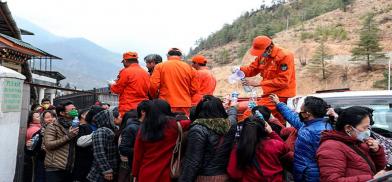Bhutan at lower risk of COVID-19
A close reading of a recent report published by the Asian Development Bank (ADB) puts Bhutan at a lower risk zone for the novel coronavirus (COVID-19)

Thimphu: A close reading of a recent report published by the Asian Development Bank (ADB) puts Bhutan at a lower risk zone for the novel coronavirus (COVID-19).
There have been only seven COVID-19 positive cases in the country, but the stakes are too high to be ignored as the government lacks adequate resources to tackle an outbreak. The country is also susceptible to cases emanating from its immediate neighbours.
One of the features that puts Bhutan at lesser risk in comparison with other countries in the region is its population density. According to the ADB report, the country’s population density is just 19.8 persons per square km, which is the lowest in the region.
The number of cases per million persons in Bhutan is 9, which is the lowest in the region. In India and Nepal cases per a million persons as of yesterday were 36.5 and 3.5 respectively.
The government has reported that 14 Bhutanese citizens living abroad have been infected. The good news is that five of the seven COVID-19 patients in the country have recovered and none died from the virus.
The World Health Organisation (WHO) has stated that people above 65 years are more susceptible to COVID-19. Death rates are also reportedly higher in older patients.
According to ADB, the share of people under 65 years in Bhutan is 92 percent. The government has prioritised protection of health and medical care of more than 50,000 older people in the country.
According to the ADB report, Bhutan has 17 hospital beds per 1,000 people, which is the highest in the region. China and the US have 42 and 29 beds per 1,000 people, respectively.
In the global health index, Bhutan ranks 85th amongst 195 countries. In the SAARC region, only India, which is at 57th position, is ranked higher than Bhutan in the global health index.
According to the health ministry, Bhutan is doing a “whole of nation approach” in combating COVID-19.
According to the report titled “South Asia Economic Focus Spring 2020”, Bhutan’s minimal caseload has allowed full isolation of those affected, with only a handful of active cases. It acknowledges Bhutan’s show of solidarity for quarantined persons as well as Bhutanese stranded abroad.
The ADB recommends governments to be stern about clamping down on stigmatising campaigns against those who have the virus or brought it, as this creates incentives for under-reporting symptoms, which only helps spread it.
Among the key initiatives being undertaken is the mobilisation of human health resources in the event of Bhutan’s transition to Red Zone. About 41 health specialists undergoing training and 92 students undergoing MBBS were recalled.
The government has also registered students who completed medical studies but not joined the civil service. Retired medical professionals have been traced and kept ready to provide regular health services releasing existing health professionals to work for COVID-19.
One of the concerns is the safety of people who are on the frontline.
There are around 3,000 health workers in the country today, according to the health ministry. The health ministry is drawing various plans to increase the strength.
According to media reports, an estimated 10 percent of those infected in Italy were healthcare workers. During the SARS outbreak in 2002, one-fifth of the total cases globally were in healthcare workers.
Health Minister Dechen Wangmo at a recent press briefing said that the health ministry had procured enough personal protective equipment (PPE) to last for at least six months if the situation remains the same as today.
She said, “The health ministry in coordination with civil society organisation (CSO) will be producing about 2,500 PPE locally.”
The CSO is said to have committed to producing about 200,000 masks to be used by people on the frontline.
The ADB report states that the difficulties involved in limiting domestic transmission of COVID-19 in South Asia are enormous. South Asia has some of the highest population densities in the world, particularly in urban areas.
It makes contagion easier, especially among the most vulnerable people, including domestic migrant workers.
“Daily positive messaging by national and local leaders can help shift behaviour.”
https://kuenselonline.com/bhutan-at-lower-risk-of-COVID-19/








Post a Comment